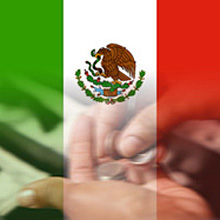
|  |  |  Business News | June 2009 Business News | June 2009  
Mexico Cuts Interest Rate for 6th Time this Year
 E. Eduardo Castillo - Associated Press E. Eduardo Castillo - Associated Press
go to original
June 20, 2009


| | The bank slashed its interbank lending rate to 4.75 percent from 5.25 percent, its sixth rate cut this year. |  |
Mexico City - Mexico's central bank cut its benchmark interest rate by a half-percentage point on Friday, signaling that it may be approaching its last rate cut of the year as it seeks to revive growth and help the country emerge from deep recession.

The bank slashed its interbank lending rate to 4.75 percent from 5.25 percent, its sixth rate cut this year. Analysts had expected the move, according to a survey of 23 financial institutions published by Grupo Financiero Banamex.

Mexico's central bank has struggled to balance efforts to fuel its shrinking economy with steps to tame nagging inflation, which has persisted as the global economic crisis slashed the value of the peso late last year. A weak peso makes imports more expensive, helping to fuel price gains despite slowing growth.

Mexico's economy contracted by 8.2 percent in the first quarter, prompting the government to officially declare Mexico's worst recession since the so-called Tequila Crisis of 1995. The bank on Thursday acknowledged that the downturn "has been severe," as exports fell by 35.6 percent in April, slashing manufacturing jobs and domestic demand.

"The strong economic contraction implies a more significant deterioration in risks to economic activity than those regarding inflation," the bank said in a statement.

The swine flu outbreak that shuttered businesses and stalled commerce for days in early May also slashed growth, although the bank said "activities most affected by this pandemic are starting to recover," boosting prospects for an uptick in economic activity in the second half of the year.

Treasury Secretary Agustin Carstens expects the flu outbreak to shave between 0.3 and 0.5 percent off gross domestic product, leaving the country with a 5.5 percent contraction this year.

Still, the bank said the downturn in industrialized countries including the U.S., which buys 80 percent of Mexican exports, appears to be "hitting bottom," and could see a recovery in the fourth quarter or early next year.

A rebound in growth could feed Mexican inflation fears, which have eased in recent months as the peso regained some ground. Having weakened by a third to a record low 15 pesos to the U.S. dollar in March, Mexico's currency has since rebounded by about 15 percent to hold steady around the 13.2 peso-to-the dollar-mark since early May.

Most emerging market currencies have rallied in recent months as surging commodity prices swell current accounts and concerns over the soaring U.S. deficit undermine the dollar. And even as their central banks cut interest rates, emerging economies still draw investors with yields that are significantly higher than U.S. Treasuries.

"That differential still favors these currencies," allowing policy makers to keep cutting rates in a bid to boost growth -- which midterm is more important for economic stability, said Alberto Ramos, senior Latin America economist at Goldman Sachs in New York.

"This hasn't been a nurturing environment for these currencies if they don't cut rates," Ramos said. "If they try to be too cute and resist cutting rates because they're afraid of their currencies weakening, they might damage their economies even more."

In Mexico, the resurgent peso has helped to slow annual inflation, which dipped to 6 percent in May, the bank said, allowing policy makers to focus on boosting economic activity.

The bank has reduced interest rates by 3.5 percentage points this year, including 75-basis-point cuts in March, April and May. Low interest rates encourage borrowing and consumption, boosting growth but also fueling price gains as consumer demand climbs.

But that easing cycle is now "close to ending," the bank declared on Thursday, saying that future rate cuts "will possibly be smaller."

"There's not much room for more cuts because inflation hasn't been ruled out yet as a problem," said Rafael Amiel, chief Latin America economist at IHS Global Insight in Eddystone, Pennsylvania.

Because industrial output has declined far faster than consumer demand, prices may come under renewed pressure when inventory supplies run out, forcing the bank to keep an eye on consumer price gains, Amiel warned.

Analysts at Barclays Capital largely agreed, saying in a note to investors that the central bank's "somewhat hawkish statement accompanying (its) decision signaled little further easing ahead."

Barclays now expects the bank to stop reducing rates next month, making a 25-basis-point cut in July to leave the rate at 4.5 percent for the year. It had previously expected the bank to stop at 4 percent in August.

Associated Press writer Theresa Bradley contributed to this report. |

 |
|  |



